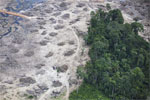Deforestation may significantly decrease the hydroelectric potential of tropical rainforest regions, warns a new study published in Proceedings of the National Academy of Science.
The study, led by Claudia M. Stickler at the International Program at the Amazon Environmental Research Institute (IPAM-International), used climate, hydrological, and land use models to forecast the impact of potential forest loss on hydropower generation on the Xingu River, a major tributary of the Amazon where the world’s third largest dam — Belo Monte — is currently under construction. They find that deforestation could inhibit rainfall and discharge by 6 to 36 percent, potentially limiting Belo Monte’s electricity output to just a quarter of its installed capacity.
Yet despite the potential impact, the researchers say that policymakers are largely failing to account for the effects of deforestation on power generation.
“The problem is that power plant designers typically ignore the effects of future deforestation. Or, if they do consider it, they presume that deforestation will increase the amount of water flowing to the dams,” said Stickler in a statement. “When we incorporated the effects of deforestation at the regional level, our results show quite the opposite.”

Satellite image of the Turucui dam and associated deforestation in Brazil. (Photo courtesy of DigitalEarth)
The paper goes on to state that the relationship between forest cover and river discharge needs incorporated into viability assessments for new hydroelectric projects. If planners want to maximize the output of their hydropower plants, then they would be wise to develop strategies to control or reverse deforestation. In the case of any dams on the Xingu River, the authors suggest re-establishing forest cover on degraded pasture on long-ago deforested lands.
“These results are extremely important for long-term energy planning,” said Marcos Costa, one of the study’s authors from the Federal University of Viçosa in Brazil, in a statement. “We are investing billions of dollars in hydropower plants around the world. The more rainforests left standing, the more water we’ll have in the rivers, and the more electricity we’ll be able to get from these projects.”
“Ending deforestation should be viewed as an issue of national energy security,” added study co-author Dan Nepstad, also of IPAM-International. Brazil has some 180,000 megawatts (MW) of untapped hydroelectric potential, although 80,000 MW of that lies in protected areas, according to The Economist.
 Above: Construction site of the Belo Monte Dam near Altamira. Photo by © Greenpeace / Marizilda Cruppe. Right: Difference in monthly power generation potential at the Belo Monte power plant on the Xingu River under alternative scenarios of local [Xingu Basin (XB)] and regional [Amazon Basin (AB)] forest cover, with climate feedbacks. (A) % difference from reference scenario in mean monthly energy generation potential under 6 alternative scenarios. (B) Mean monthly power generation potential as a % of maximum installed capacity under 7 alternative scenarios. |

|
However the authors note that dams themselves bring a litany of concerns, including ecological damage to rivers and surrounding forest areas, forced displacement of local people, increased pressure for deforestation, and new vectors for disease. A tropical dam can also exacerbate climate change by releasing greenhouse gases in the form of methane from decaying organic matter at the bottom of its reservoir. Phillip Fearnside, a scientist not involved in the latest PNAS study, has called Amazon dams “methane factories” for their climate impact.
The paper is timely considering the number of dams that are planned in tropical regions around the world. For example Amazon counties have built or are planning to develop more than 400 dams in the Amazon Basin alone. Meanwhile dozens of dams are slated for the Mekong basin, the Malaysian state of Sarawak, and Central Africa. Each of these regions is experiencing high rates of forest loss, calling into question hydropower forecasts should deforestation continue.
“Like other energy sources, hydropower plants present large social and environmental costs,” the authors write. “Their reliability as energy sources, however, must take into account their dependence on forests.”
CITATION: Stickler et al. (2013) Dependence of hydropower energy generation on forests in the Amazon Basin at local. PNAS May 17, 2013. www.pnas.org/cgi/doi/10.1073/pnas.1215331110
Related articles
Tribesmen launch ‘occupy’ protest at dam site in the Amazon rainforest
(05/03/2013) On Thursday roughly 200 indigenous people launched an occupation of a key construction site for the controversial Belo Monte dam in the Brazilian Amazon. The protestors, who represent communities that will be affected by the massive dam, are demanding immediate suspension of all work on hydroelectric projects on the Xingu, Tapajós and Teles Pires rivers until they are properly consulted, according to a coalition of environmental groups opposing the projects.
The river of plenty: uncovering the secrets of the amazing Mekong

(04/23/2013) Home to giant catfish and stingrays, feeding over 60 million people, and with the largest abundance of freshwater fish in the world, the Mekong River, and its numerous tributaries, brings food, culture, and life to much of Southeast Asia. Despite this, little is known about the biodiversity and ecosystems of the Mekong, which is second only to the Amazon in terms of freshwater biodiversity. Meanwhile, the river is facing an existential crisis in the form of 77 proposed dams, while population growth, pollution, and development further imperil this understudied, but vast, ecosystem.
Judge halts military-backed dam assessment in Brazil’s Amazon
(04/17/2013) A federal court in Brazil has suspended the use of military and police personnel during technical research on the controversial São Luíz do Tapajós Dam in the Brazilian Amazon. The military and police were brought in to stamp down protests from indigenous people living along the Tapajós River, but the judge decreed that impacted indigenous groups must give free, prior, and informed consent (FPIC) before any furter studies can be done on the proposed dam. However, the decision is expected to be appealed.
Amazon river ecosystems being rapidly degraded, but remain neglected by conservation efforts
(02/08/2013) The world’s largest river system is being rapidly degraded and imperiled by dams, mining, overfishing, and deforestation, warns a study published last week by an international team of scientists.
Fish unable to pass through dams in U.S. presents ‘cautionary tale’ for developing world
(01/17/2013) Dams create a largely impenetrable barrier for fish even when the dams were installed with specially-built passages, according to a new study in Conservation Letters. The scientists found that migrating fish largely failed to use the passages in the U.S., resulting in far fewer moving through the state-of-the-art hydroelectric dams than had been promised. The researchers say that their findings are a “cautionary tale” for developing nations.
Dams are rapidly damning the Amazon
(12/08/2012) Dam-builders seeking to unlock the hydroelectric potential of the Amazon are putting the world’s mightiest river and rainforest at risk, suggests a new assessment that charts the rapid expansion of dams in the region.
Brazil decree opens tribal lands to mining, dams in ‘national interest’

(07/26/2012) A directive signed Monday by Brazil’s Solicitor-General could hamper the efforts of indigenous tribes to win government recognition of their traditional lands, reports Survival International, a human rights group focused on native peoples. The directive ‘opens up all indigenous areas to mineral, dams, roads, military bases and other developments of ‘national interest’ without the need to consult with or address concerns of indigenous peoples’, according to an expert familiar with the directive.
Dams are ‘centerpiece of greenwashing’ in the Amazon
(06/25/2012) Brazil’s ambitious plans to build 30 dams in the Amazon basin could trump the country’s efforts to protect the world’s largest rainforest, said a leading Amazon scientist speaking at the annual meeting of the Association for Tropical Biology and Conservation (ATBC) in Bonito, Brazil.
Tropical dams are a false solution to climate change
(05/27/2012) Tropical dams emit considerably more greenhouse gas emissions than their temperate counterparts yet are being treated as a solution to climate change, warns a report published in Nature Climate Change.
Will mega-dams destroy the Amazon?

(04/18/2012) More than 150 new dams planned across the Amazon basin could significantly disrupt the ecological connectivity of the Amazon River to the Andes with substantial impacts for fish populations, nutrient cycling, and the health of Earth’s largest rainforest, warns a comprehensive study published in the journal PLoS ONE. Scouring public data and submitting information requests to governments, researchers Matt Finer of Save America’s Forests and Clinton Jenkins of North Carolina State University documented plans for new dams in Bolivia, Brazil, Colombia, Ecuador, and Peru.
Pictures: Destruction of the Amazon’s Xingu River begins for Belo Monte Dam

(04/18/2012) The Xingu River will never be the same. Construction of Belo Monte Dam has begun in the Brazilian Amazon, as shown by these photos taken by Greenpeace, some of the first images of the hugely controversial project. Indigenous groups have opposed the dam vigorously for decades, fearing that it will upend their way of life. Environmentalists warn that the impacts of the dam—deforestation, methane emissions, and an irreparable changes to the Xingu River’s ecosystem—far outweigh any benefits. The dam, which would be the world’s third largest, is expected to displace 16,000 people according to the government, though some NGOs put the number at 40,000. The dam will flood over 40,000 hectares of pristine rainforest, an area nearly seven times the size of Manhattan.